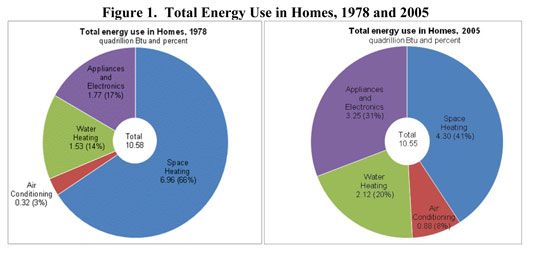There are many promises that a smarter grid could unlock. One is a more efficient, reliable electricity delivery system. Another is a connected world where our homes and offices can talk to the grid in real time, shedding load to avoid summer blackouts. Smart meters, in particular, will give us all insight into our energy use so that we can save money and energy.
The latter promise, however, is far from a given if historic energy use in homes is any indication.
From 1978 to 2005, energy use in homes is essentially a flat line. There have been incredible efficiency gains, primarily in home heating and cooling, but that has been offset by bigger homes and more stuff that needs to be plugged in.

In a paper recently published by the U.S. Energy Information Administration at an event hosted by the American Council for an Energy-Efficient Economy, the authors question whether meaningful energy reductions can actually be achieved in the U.S. housing stock.
Even companies that have built business models around helping people understand and reduce their energy see the problem. Opower recently estimated that all of the second refrigerators in America suck up the equivalent energy use of 1.7 million homes.
The answer is not to ask the 23 percent of homeowners who have second refrigerators to toss them to the curb. It's unrealistic that Americans will simply consume far less than they currently do. But the question of how to get real, meaningful energy reductions across the bulk of homes is a problem when efficiency standards can barely keeping up with all of the stuff we’re buying.
At smart grid conferences, speakers often remind the audience that utilities aren’t selling kilowatts; they’re selling “cold beer and warm showers.” Even when people upgrade their appliances, the old fridge might go to the garage or the old TV goes down in the basement.
“All of these factors combine to make any attempt to decrease or even maintain household energy consumption very challenging,” the authors concluded. “Efficiency programs must decrease energy use not just from current products but from an ever increasing number of end-uses.”
Platforms like Opower, which deliver energy reports, are a starting point, but will likely not be enough in the long term. In another study, the ACEEE asks, “How important are the estimated two to ten percent residential sector savings from feedback programs, especially as they might compare to other recent estimates of national electricity savings potential from all sectors at some point in the future?”
One solution is to drive efficiency standards for new products as they come out. Set-top boxes, for instance, are going to get their first energy efficiency standards set soon, although they’ve been in the marketplace for decades. Standards are also different than smart appliances, which in most cases would have a minimal impact on overall energy use, as large appliances (outside of water heaters and AC units) are not the energy hogs they once were.
ACEEE also advocates for leveraging smart meters and other technology to deliver increasingly sophisticated feedback to homeowners. For now, it’s unclear if utilities are interested in funding tech-heavy programs, unless they have specific pain points, like Oklahoma Gas & Electric trying to delay new generation. Real efficiency will also likely take more than technology. Retrofits are where the real savings are, but again there needs to be money available and interest from homeowners, which is far harder than it sounds.
Although companies in the home energy efficiency space claim millions of customers with lots of aggregate savings, it is still entirely unclear if these platforms can offset the extra fridge in the garage, the third big-screen TV or one more laptop.



